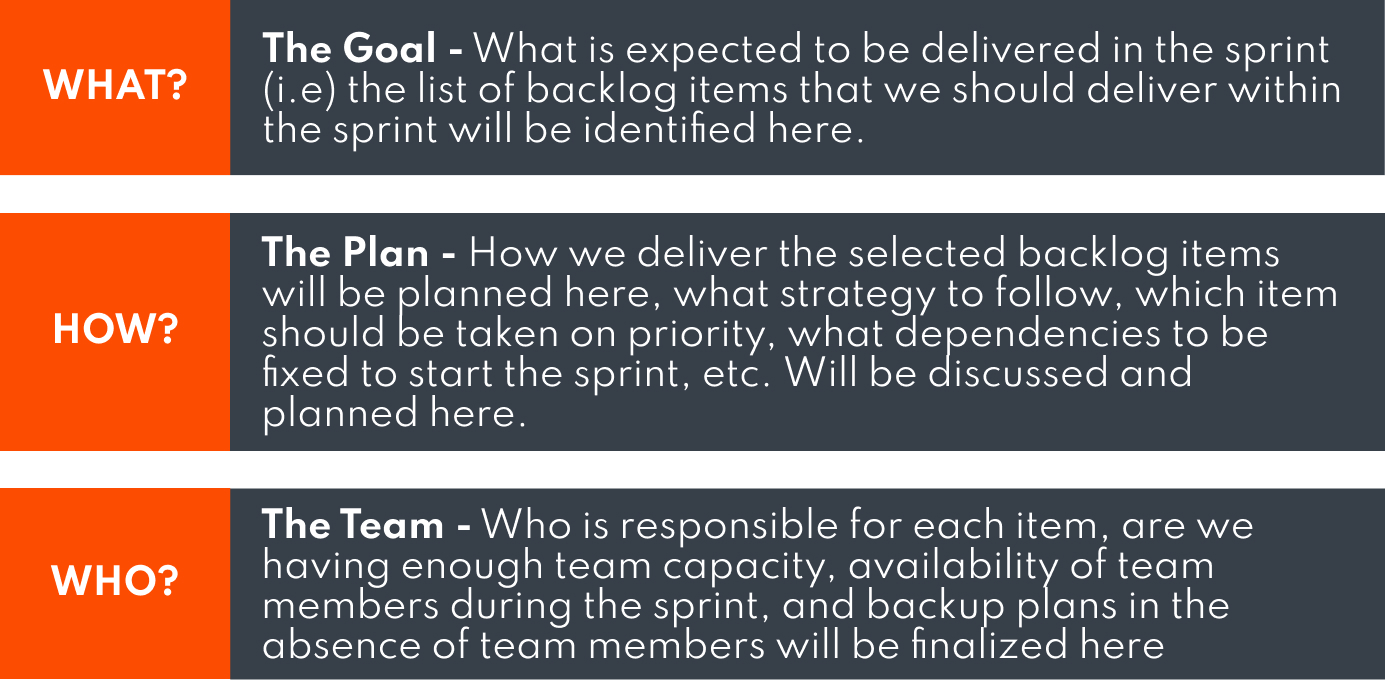Introduction
Sprint planning is an essential component of Agile in which the entire team defines what can be delivered in a sprint and how to achieve it. Though you can find enough information about sprint planning online, there still needs to be more clarity on a QA engineer's roles and responsibilities in sprint planning.
Find out what a QA engineer does to enhance their contribution to sprint planning here.
What Is Agile
Agile is an iterative approach to project management in which software development is done in several phases. In each phase, there is constant collaboration with stakeholders to accomplish continuous improvement.
Benefits Of Agile Methodology
The Agile methodology helps the team:
- Deliver fast by targeting shorter development cycles and more frequent releases
- Achieve greater flexibility that allows regular adaptation to change requirements at any time of the project
- Ensure constant collaboration with stakeholders to give real-time visibility of the progress of the application development
What Is Sprint Planning
Sprint planning identifies the sprint backlog before the start of every sprint. This involves the entire delivery team understanding the backlog and prioritizing items. The final output is to commit a team to deliver the identified backlog items within that sprint.
Fundamental Attributes Of Sprint Planning
The three fundamental attributes of sprint planning are:
- The Goal
- The Plan
- The Team

Why We Need Sprint Planning
Let's assume there is a goal, a plan to execute it, and a team to work on it. But how to get the team on the same page?
This can be done through sprint planning. Sprint planning helps ensure that the entire scrum team agrees on what, when, how, and by whom the plan will be executed to meet the sprint goal. The benefits of following this are successful delivery and customer satisfaction.
Successful Delivery
A project's success is always measured by the milestones delivered, and proper sprint planning is the first step in achieving the milestone delivery. Successful delivery also refers to:
- A well-defined goal has a direct effect on the productivity of the team. This is done by providing clarity and transparency to the team on what's expected.
- Acceptable planning saves a lot of time and effort by clearly putting the prioritization, dependencies, and requirements ahead with the team.
- It also creates the space for the entire team to analyze and decide on what can be delivered within the sprint by considering the team's capacity and knowledge.
- Planning as a team helps increase team coordination throughout the sprint delivery and brings more focus to meeting the agreed sprint goal.
Customer Satisfaction
Sprint planning is a key phase in agile that allows delivery services to meet and sometimes exceed customer expectations. Customer satisfaction is achieved by:
- Planning a sprint from the customer's point of view and prioritizing the backlog items that hold more value.
- Easy adaptability to new requirement changes when it's discussed with the appropriate action plan. This ensures a sprint delivery is done in alignment with customer expectations.
- Avoid risks by discussing and fixing all potential issues before the sprint starts.
The Roles And Responsibilities Of A QA Engineer
Sprint planning is an integral phase of the agile process, which is why QA should play an important role from the start by establishing responsibilities. Some primary tasks in which QA engineers should be involved from the start of the sprint planning are:
- Providing Estimation
- Backlog Prioritization
- Story Optimization
- Risk Identification
- Test Planning
Providing Estimation
Other teams within a sprint often overlook testing time. It leads to an unreliable sprint plan with little to no time consideration for QA. The solution to this involves producing an accurate QA estimation that can be done by considering the following factors.
Knowledge About Requirements
QA should spend enough time understanding the features before providing an estimation. More information on the requirements will help break down the test scenarios effectively, and test estimations can be planned appropriately.
Awareness Of Feature Complexity
This should be communicated ahead from a technical perspective by a technical architect or a developer. Testing timelines of such features will evolve along with the project's complexity.
Testing Dependencies
All necessary documentation like FSD, design documents, technical architecture, and validation tickets should be ready for testing reference. Beyond this, the readiness of the test management tool, resource availability, test case design, technical walkthrough from developers, and test environment readiness should be counted as dependencies for estimation.
The final estimation should cover the following tasks.
- Analysis and understanding of requirements
- Planning test scenarios and scripting
- Test execution and reporting
- Browsers or devices coverage
- Defect logging and triaging
- Selecting regression candidates
- Designing regression test suite
- Execution and reporting of regression tests
Backlog Prioritization
Priorities set from a testing standpoint have a major impact on sprint planning. This is why sprint planning should always be in alignment with the overall project priorities. And the prioritization of stories within a sprint should consider sprint-level dependencies.
Consider the following points to make sprint prioritization advantageous to QA.
Handling Complex And Time-Consuming Features
Developing the most complex tasks will take time, and test coverage can get delayed if it is planned in the later stage of the sprint. Avoid this delay by handling complex and time-consuming features at the sprint's start.
Check Validation Dependencies Between Stories
Some feature validation can be done when its dependent feature is ready. Development of such features can be independent, but testing will be affected due to the dependency. For example, validating an account page without a login feature is impossible. In these cases, the dependent feature should be prioritized in the sprint so that testing is not blocked.
Avoid Repeated Testing
Deployment of some critical features at the sprint end might create a need to retest already tested features in a limited timeline. This test repetition can be avoided by prioritizing all critical features at the sprint beginning.
Prioritizing Minor Tasks And Bug Fixes
It is an excellent approach to prioritize some critical bugs from the backlog. This will ensure proper utilization of a sprint along with test scripting and test data preparation work.
Story Optimization
It is obligatory to have a thorough understanding of the requirements for sprint planning. This is possible only when the story details are complete, acceptance criteria are up to date, and reference documents or designs are well-equipped.
QA should take a considerable part in user story optimization by identifying variations between FSD, stories, and design early in the sprint. Refocusing requirement gaps at the sprint beginning will bring down unwanted iterations. This will save sprint time and the effort involved.
Beyond this, QA can also help understand the requirement from an end-user perspective and highlight the logical gaps. Reviewing and understanding the story acceptance criteria is one of the key activities of QA engineers at the beginning of every sprint. At this stage, any requirements or technical queries should be clarified before starting the testing activities for complete test coverage.
Risk Identification
Participation of QA in sprint planning helps identify associated risks in testing, and respective measures can be planned. Some of the forms of risk that can be handled are:
- Delivery delays and missing deadlines
- Lack of training and resources
- Lack of communication
- Unavailability or Issue in the test environment
- Technical dependencies
QA can keep the communication overhead and handle the anticipated risks by being part of sprint planning.
Test Planning
Involvement in sprint planning helps QA to decide which tickets and tasks need to be prioritized. This can help the team achieve better time management and sprint delivery. It can be done by:
- Planning build dates for the tickets based on the testing timeline. This will create a quick delivery schedule so the entire team will be in sync with when the tickets will be released for testing.
- Testing scripts for prioritized tickets right after the sprint planning. This will provide enough test scripting activity time and avoid overlapping the execution timeline.
- Completing regression test planning parallelly based on the complexity of the ticket. Regression candidates selection and updating of the regression suites can be started for that sprint in the early phase. This will give QA ample time to optimize the regression suite and execute the same.
Additionally, sprint zero activities involving test documentation like standard operation procedure(SOP), test plan, test strategy preparation, and selection of automation tools should be completed and approved by client teams. The readiness of the test environment and defining quality metrics should be agreed upon across the agile team for uninterrupted testing work from the first sprint.
Common Mistakes QA Should Avoid In Sprint Planning
Avoid making a few common mistakes that often result in a failed sprint delivery.
- Accepting unrealistic goals or timelines just to be in sync with the rest of the team will make the QA delivery unachievable and highly affect the quality of work.
- Unprepared participation or having no prior understanding of the backlog items to be discussed in the planning session will merely fail QA to communicate the dependencies and prioritization to the team.
- Planning for the entire capacity of the team is not always a good idea. Considering shortcomings, unexpected additional effort, or unforeseen situations is the best way to avoid team burnout.
- Not focusing on the latest feedback, updates, or requirement changes might result in an incorrect test planning and delivery context.
Conclusion
A sprint planned without a QA engineer is not a well-planned sprint. All the above-mentioned QA roles and responsibilities in sprint planning, individually or as a whole, will significantly help achieve the sprint goal and engineer quality at speed.

Saranya Rajaram, Senior Business Analyst
Saranya enjoys transforming business needs into reality by delivering business-aligned solutions that create value for clients. She thrives in crafting solutions that meet both business objectives and user expectations, ensuring smooth and impactful outcomes. Outside of work, she channels her energy into creative pursuits like dancing and enjoying music, all while maintaining a positive outlook and a problem-solving mindset

 We respect your privacy. Your information is safe.
We respect your privacy. Your information is safe.



Leave us a comment